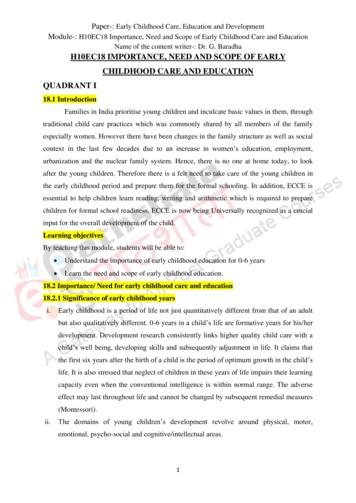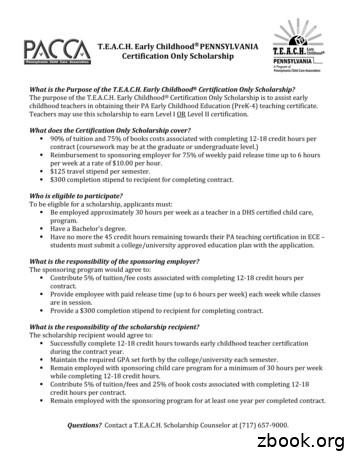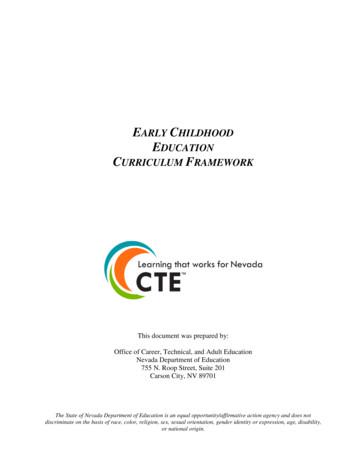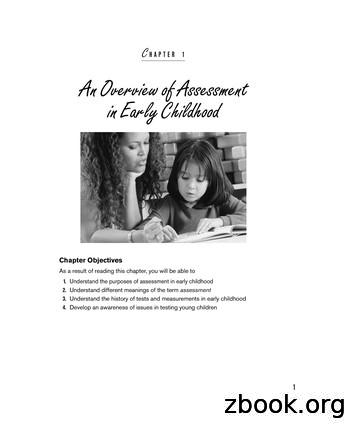Early Childhood Standards Of Quality
Early ChildhoodStandards of Qualityfor Infant and Toddler ProgramsMichigan State Board of EducationInitially Approved December 12, 2006Revised March 12, 2013powered by the and Michigan’s Great Start CollaborativesEARLY CHILDHOOD STANDARDS OF QUALITY FOR INFANT AND TODDLER PROGRAMSa
2013 Michigan State Board of Education. This document may be freely reproducedwithout permission for non-profit educational purposes. Use of, or reference to, thisdocument should cite: Michigan State Board of Education, Lansing, MI. (2013). EarlyChildhood Standards of Quality for Infant and Toddler Programs.The strands, most goals and some text: Crown copyright 1996 New Zealand. Adapted from: Ministry of Education (1996).Te Whˉariki: He Whˉariki Mˉatauranga mˉo ngˉa Mokopuna o Aotearoa: Early ChildhoodCurriculum. Wellington, New Zealand: Learning Media.
TABLEOFCONTENTSAcknowledgments . . . . . . . . . . . . . . . . . . . . . . . . . . . . . . . . 2Introduction . . . . . . . . . . . . . . . . . . . . . . . . . . . . . . . . . . . 11Alignment with Related Documents . . . . . . . . . . . . . . . . . . . . . 15Early Development and Learning Strands for Infants and Toddlers . . . . . 17Introduction . . . . . . . . . . . . . . . . . . . . . . . . . . . . . . . . . . 17Strand A – Well-being . . . . . . . . . . . . . . . . . . . . . . . . . . . . . 20Strand B – Belonging . . . . . . . . . . . . . . . . . . . . . . . . . . . . . 26Strand C – Exploration . . . . . . . . . . . . . . . . . . . . . . . . . . . . 35Strand D – Communication . . . . . . . . . . . . . . . . . . . . . . . . . . 44Strand E – Contribution . . . . . . . . . . . . . . . . . . . . . . . . . . . . 51Quality Program Standards for Infant and Toddler Programs . . . . . . . 60Introduction . . . . . . . . . . . . . . . . . . . . . . . . . . . . . . . . . . 60A. The Program’s Statement of Philosophy . . . . . . . . . . . . . . . . . 62B. Community Collaboration and Financial Support . . . . . . . . . . . . . 65C. Physical and Mental Health, Nutrition, and Safety . . . . . . . . . . . . 68D. Staffing and Administrative Support and Professional Development . . . 74E. An Environment of Care and Learning . . . . . . . . . . . . . . . . . . 81Program Structure (Standards 1 through 7) . . . . . . . . . . . . . . . . 83Relationships and Climate (Standards 8 through 12) . . . . . . . . . . . 86Space, Equipment and Materials (Standards 13 through 15) . . . . . . . 89Activities and Experiences (Standards 16 through 20) . . . . . . . . . . 91F. Child Assessment and Program Evaluation . . . . . . . . . . . . . . . . 95Glossary . . . . . . . . . . . . . . . . . . . . . . . . . . . . . . . . . . . . 100EARLY CHILDHOOD STANDARDS OF QUALITY FOR INFANT AND TODDLER PROGRAMS1
AcknowledgmentsThe Michigan State Board of Education adopted early learningexpectations for children in the preprimary age group of 3-5 yearsas early as the 1970s.After the Michigan State Board of Education approved the latestrendition of these guidelines, Early Childhood Standards of Qualityfor Prekindergarten (ECSQ-PK) in March 2005, early childhood leadersand practitioners in Michigan turned their thoughts immediately to a similardocument to address both early learning outcomes and quality programstandards for settings serving infants and toddlers. It was clear that the newdocument would be more difficult to develop since it would be “from scratch,”where the ECSQ-PK document was a revision and compilation of previouswork. Starting from the ECSQ-PK framework, an Ad Hoc Committee and aSteering Committee were convened, and work began in the spring of 2005.Quality in program standards, although calling for much discussion, was notterribly difficult to define. The groups decided early that program standards wouldneed to address family and group family child care settings as well as centerbased, classroom programs, since so many infants and toddlers are cared for infamily settings. The committee considered child care licensing rules as the basisfor a system of quality programming, and built upon, but did not necessarily repeat,those rules in these quality standards. The decision was also made not to includerelative and aide, or nanny care, whether it occurred in the child’s own home orthe caregiver’s home, unless the home was regulated by child care licensing rules.The ECSQ-PK document provided guidance in many areas and the final documentincludes topics similar to the topics for preschool children, although the relationshipwith families permeates the other standards in the infant-toddler document and isnot set aside separately as it is for the preschool document.Defining reasonable outcomes for infants’ and toddlers’ development andlearning proved a much more difficult task. The Ad Hoc Committee met anddiscussed a framework based on five developmental areas set out by the NationalEducational Goals Panel in the early 1990s: Physical Well-Being and MotorDevelopment, Social and Emotional Development, Approaches Toward Learning,Language Development, and Cognition and General Knowledge. The frameworkof these five developmental domains was used in the ECSQ-PK document, withadditions to make clear the alignment to grade level expectations in kindergartenand the primary grades. Similar documents for infants and toddlers from other stateswere consulted, and a working draft was developed. The Steering Committee metto review this initial draft, and members were very uncomfortable. The frameworkresembled a checklist or developmental wheel; the information included was readily2MICHIGAN DEPARTMENT OF EDUCATION
available at any bookstore with a section on parenting or child development. Thecommittee considered what contribution this document could make and whatinfluence it would have on the field. Would it negatively reduce the importanceof infant and toddler programs to merely making sure children were meeting thedevelopmental milestones in a timely manner? Worse, might it be used to assesschildren who are within the wide range of “normal” development and encourageprograms to help children reach certain milestones prematurely? Would that helpmeet the agreed-upon goal of making sure children in the earliest years are “safe,healthy, and eager to succeed in school and in life”? The Steering Committee asked:What contribution could the State Board of Education definitions of reasonableearly development and learning outcomes make to the early childhood field? Howcould the State Board of Education promote the highest practices in settings forinfants and toddlers that would help reach the state-wide goal? Clearly, the SteeringCommittee was searching for an alternate framework that would include goals forchildren’s development and learning, but in a broader, environmental context. Thecommittee expressly wanted the responsibility for children’s development to fallon the adults in children’s lives, their families and caregivers, and not on the smallshoulders of babies and toddlers.One member of the Steering Committee was familiar with the work that had beendone in New Zealand on early childhood curriculum theory and practice, Te Whˉariki1.In te reo Mˉaori, the language of the indigenous people of New Zealand, Te Whˉarikiliterally means a woven mat. In this context, Te Whˉariki refers to the interwovenprinciples and strands that together form the whˉariki or framework of the curriculum.In New Zealand, there are many ways in which each early childhood program canweave the particular pattern that makes its program different and distinctive, creatingan integrated foundation — a whˉariki — for each child’s development and learning.The Steering Committee was very attracted to the work in New Zealand,but very clear that the principles on which the work was based could not applydirectly and wholly in Michigan. New Zealand’s work focuses very much on thecultural context; Michigan is very different culturally from New Zealand. Michigan’sdocument is a derivation of the New Zealand early childhood curriculum frameworkand not a direct carry-over. In New Zealand, the socio-cultural basis of thedocument leads to a move away from a focus on developmental expectations toa more expansive view of learning outcomes for young children. It is this largerview of learning outcomes that the Michigan committee shares with New Zealand,but because of the differing cultural context, it must be emphasized that the workis not the same, and the document that follows reflects Michigan’s children, theirfamilies, and those who also care for and educate them. We are very thankful toour colleagues in New Zealand for allowing us to use their framework to spur newthinking and support for the youngest children in Michigan.New Zealand Ministry of Education. (1996). Te Whˉariki: He Whˉariki Mataurangaˉm oˉ ngaˉ Mokopunao Aotearoa: Early Childhood Curriculum. Wellington, New Zealand: Learning Media. Available at:www.minedu.govt.nz/goto/tewhariki.1EARLY CHILDHOOD STANDARDS OF QUALITY FOR INFANT AND TODDLER PROGRAMS3
Because the Steering Committee and Ad Hoc Committee were familiarwith concepts about alignment, and cognizant of the need to be able to alignlearning for children over time, many of the ideas in this document for infant andtoddler programs are stated in ways that are similar to the statements in ECSQPK. However, children’s development is not a straight line; one discrete skill ormilestone does not lead directly to another in a single chain of developments. Forthe very youngest, it is difficult to differentiate between developmental domainssuch as approaches to learning, social and emotional development, languageand cognition. For example, a baby first calling her father — and no one else— “dada,” is demonstrating her emotional connection to a familiar adult, hernewly-found communicative ability to repeat a sound and attach meaning to it,a cognitive understanding of object constancy, initiative, and so on. If any one ofthese is missing, the child probably won’t develop this particular skill. One actionfalls in many domains — and that skill will later lead to a number of other skills in avariety of domains. The Steering Committee tried to find an image to describe theconnection among the various developmental and learning outcomes. Alignmentsuggests that the connections are linear. Inspired by Te Wh ariki, the committeebegan to talk about weaving and braiding, where strands of development twisttogether and later unravel in new ways. Perhaps the image is of a tree, where theroots are the strands in this document, and the skills we see later are the branchesand leaves. It may not be possible to trace all the connections directly, but the earlydevelopments all contribute to the later accomplishments.In 2011, the Office of Great Start was created by Executive Order2 to lead thework of the Great Start system to achieve these Prenatal to Age 8 Outcomes: Children born healthy; Children healthy, thriving, and developmentally on track from birth to thirdgrade; Children developmentally ready to succeed in school at the time of schoolentry; and Children prepared to succeed in fourth grade and beyond by readingproficiently by the end of third grade.To achieve these outcomes, a project to update and expand the EarlyChildhood Standards of Quality documents was undertaken.From 2011 to 2013, Ad Hoc Committees were again convened to update andrevise Early Childhood Standards of Quality for Infant and Toddler Programsand Early Childhood Standards of Quality for Prekindergarten. A third document,Early Childhood Standards of Quality for Kindergarten through Third Grade wasproposed, and a program standards document for before- and after-school andsummer programs for school-age children and youth, Michigan Out-of-SchoolTime Standards was revised and accepted by the State Board of Education.Recommendations of activities and an extensive longitudinal alignment were2Office of the Governor. (2011). Available at: http://michigan.gov/documents/snyder/EO-20118 357030 7.pdf4MICHIGAN DEPARTMENT OF EDUCATION
also completed. When used together, this suite of standards for programs andexpectations for young children, in all programs and settings, in school and out ofschool, provides a framework for the Great Start System.Listed on the next pages are the members of the original 2005-2006 Ad HocCommittee and the Steering Committee. Their task continued long beyond the initialtimeline, with many more meetings and discussions and revisions than originallyplanned. Their dedication to the very youngest children in Michigan has led to thisremarkable document. Also listed are the members reconvened in 2011-2013 toreview and update the document to support the work of the Office of Great Start inachieving the prenatal outcomes to age 8. Their work was thorough and inspiring.ACKNOWLEDGMENTSEarly Childhood Standards of Quality for Infant and Toddler Programs AdHoc Advisory Committee, 2005-2006MaDonna AdkinsEarly Head StartEightCAP, Inc. Head StartSally AdlerChild Care Professional ProgramWashtenaw Community CollegeKathleen BaltmanInfant Mental HealthThe Guidance CenterSr. Barbara ClineEarly On Training and TechnicalAssistanceClinton County Regional EducationalService AgencyTerri ColasaccoEarly Head Start/Head StartNorthwest Michigan HumanServices Agency, Inc.Hollie BarthMidland County Health DepartmentIngrid DavisMaternal Infant Health ProgramsMichigan Department of CommunityHealthHolly Brophy-HerbDepartment of Family and ChildEcologyMichigan State UniversityReneé De Mars-JohnsonInfant/Toddler and Family ServicesMichigan Department of EducationLindy BuchOffice of Early Childhood Educationand Family ServicesMichigan Department of EducationReenie ButlerEarly Head Start/Head StartChippewa-Luce-MackinacCommunityAction Human Resource AuthorityMary DelucaEarly Head Start/Head StartCommunity Action Agency Head StartSusan DupayChild Development Services of OttawaCountyJoan EcclesineEarly Head Start/Head StartMenominee-Delta-SchoolcraftCommunity Action AgencyEARLY CHILDHOOD STANDARDS OF QUALITY FOR INFANT AND TODDLER PROGRAMS5
Harriet EgertsonEarly Childhood ConsultantLaura Jensen-HuntEarly On ParentNorma EppingerMichigan 4C AssociationTonya KirklandFamily Group Child Care HomeOwnerAlma FerrellEarly Head Start/Head StartSoutheast Children and FamilyDevelopmentJoan FirestoneEarly ChildhoodOakland SchoolsTammy FunnellEarly Head StartMid-Michigan Community ActionAgencyJoyce GooderOffice of Early Childhood Educationand Family ServicesMichigan Department of EducationJudy Goth-OwensChild Development ProgramLansing Community College andAmerican Associate Degree EarlyChildhood EducatorsJennifer HartHearing ProgramMichigan Department of CommunityHealthShelley HawverEarly Head StartCommunity Action Agency Head StartCriss HickeyEarly On ParentEarly On Training and TechnicalAssistanceSandra HoweEven StartMichigan Department of EducationJill IskowEarly Childhood ProgramsHuron Intermediate School District6MICHIGAN DEPARTMENT OF EDUCATIONJudy LevineOffice of Early Childhood Educationand Family ServicesMichigan Department of EducationDebra LivelyEarly ChildhoodSaginaw Valley State UniversityRichard LowerMichigan Head Start AssociationMary LudtkeMental Health Services to Childrenand FamiliesMichigan Department of CommunityHealthCharlotte LukasiewiczFamily Child Care Home OwnerMary MackrainMichigan Child Care ExpulsionPrevention InitiativeMichigan Department of CommunityHealthTeresa MarvinEarly On ParentKristen McDonaldMichigan Department of EducationMischele McManusEarly On Michigan Department of EducationMelissa Mendez-BegnalEarly Head Start/Head StartCommunity Action Agency Head StartJoanne MitchellRegion V Head Start TechnicalAssistance Network
Lena MontgomeryWayne Regional Educational ServiceAgencyLaurie NicksonMichigan Association for theEducation of Young ChildrenNelle PeckEarly Head StartMichigan Family Resources HeadStartNancy PeelerEarly On Michigan Department of CommunityHealthStephanie PetersEarly On Ingham Intermediate School DistrictKathi PioszakEarly Childhood InvestmentCorporation and MichiganDepartment of Human ServicesChildren’s Services AdministrationJoan ScalesEarly Head Start/Head StartSoutheast Children and FamilyDevelopmentMary ScoblicChild Health UnitMichigan Department of CommunityHealthNancy SecorEarly Head Start/Head StartEightCAP, Inc. Head StartSheila SemlerOral Health ProgramMichigan Department of CommunityHealthMelody J. SievertState Child Care AdministratorMichigan Department of HumanServicesKathryn SimsEarly Childhood Mental HealthConsultantTheresia PrinceDepartment of Human Services of theCity of Detroit Head StartMary StumpEarly Head Start/Head StartCommunity Action AgencyGinny PurcellEarly Head Start/Head StartCommunity Action Agency of SouthCentral MichiganBetty TablemanMichigan Association for Infant MentalHealthMichigan State UniversitySandy RademacherChild Day Care LicensingMichigan Department of HumanServicesDeborah WeatherstonMichigan Association for Infant MentalHealthDawn RitterEarly On Michigan Department of HumanServicesRosemary RowlandParentCarolyn RutledgeEarly Head StartCarman-Ainsworth CommunitySchoolsWilliam B. Weil, Jr., M.D.PediatricsMichigan State UniversityNancy WillyardMichigan Head Start-StateCollaboration OfficeMichigan Department of HumanServicesVanessa WinborneEarly On Michigan Department of EducationEARLY CHILDHOOD STANDARDS OF QUALITY FOR INFANT AND TODDLER PROGRAMS7
Jessica WolfEarly On Michigan Department of EducationBetty YanceyMichigan Public Health InstituteMichigan Nurse-Family PartnershipCandra WombleFamily Group Child Care HomeOwnerGeorge ZarkaVision ProgramMichigan Department of CommunityHealthJackie WoodInfant/Toddler and Family ServicesMichigan Department of EducationEarly Childhood Standards of Quality for Infant and Toddler Programs AdHoc Advisory Committee, 2011-2013Sally AdlerWashtenaw Community CollegeSusan AndersenTechnical WriterKathleen BaltmanThe Guidance CenterIMHRobin BozekMichigan Head Start AssociationLisa Brewer-WalravenOffice of Great StartMichigan Department of EducationSusan BromanOffice of Great Start MichiganDepartment of EducationLindy BuchOffice of Great StartMichigan Department of EducationLinda DannMichigan Department of CommunityHealthProject LAUNCHReneé DeMars-JohnsonOffice of Great StartMichigan Department of EducationHarriet EgertsonTechnical Writer8MICHIGAN DEPARTMENT OF EDUCATIONChris FarrellMichigan Department of CommunityHealthHealth-Oral HealthJoan Firestone, Ph.D.Oakland SchoolsRosemary FournierMichigan Department of CommunityHealthFetal Infant Mortality ReviewLonias GilmoreMichigan Department of CommunityHealthNutrition and Physical Activity/Childhood ObesityLaura GoldthwaitOffice of Great StartMichigan Department of EducationJudy Goth-OwensLansing Community CollegeACCESSPatricia HeilerMichigan Department of CommunityHealthNutrition and Physical Activity/Childhood ObesityKelly HursheOffice of Great StartMichigan Department of Education
Laurie LinscottMichigan State UniversityLaurie NicksonMichigan Association of the Educationof Young ChildrenKaren LishinskiMichigan Department of CommunityHealthChildhood Lead/Healthy HomesNurseColleen O’ConnorOffice of Great StartMichigan Department of EducationDebra LivelySaginaw Valley State UniversityNancy PeelerMichigan Department of CommunityHealthIMHRichard LowerOffice of Great StartMichigan Department of EducationJeremy ReuterOffice of Great StartMichigan Department of EducationMary LudtkeMic
EARLY CHILDHOOD STANDARDS OF QUALITY FOR INFANT AND TODDLER PROGRAMS. a. powered by the. and . Michigan’s Great Start. Collaboratives. Michigan State Board of Education. Initially Approved December 12, 2006. Revised March 12, 2013. Early Childhood . Standards . of . Quality. for . Infant. and . Toddler Programs
Understand the importance of early childhood education for 0-6 years Learn the need and scope of early childhood education. 18.2 Importance/ Need for early childhood care and education 18.2.1 Significance of early childhood years i. Early childhood is a period of life not just quantitatively different from that of an adult
T.E.A.C.H. Early Childhoodâ PENNSYLVANIA Certification Only Scholarship What is the Purpose of the T.E.A.C.H. Early Childhood Certification Only Scholarship? The purpose of the T.E.A.C.H. Early Childhood Certification Only Scholarship is to assist early childhood teachers in obtaining their PA Early Childhood Education (PreK-4) teaching certificate.
Early Childhood Education I L1 Early Childhood Education II L2 Early Childhood Education III L3C Early Childhood Education Advanced Studies AS The core course sequencing with the complementary courses provided in the following table serves as a guide to schools for their programs of study.
CHAPTER 1 An Overview of Assessment in Early Childhood Understanding Assessment in Infancy and Early Childhood Not too long ago, resources on early childhood assessment were limited to occa-sional articles in journals, chapters in textbooks on teaching in early childhood pro-grams, and a few small textbooks that were used as secondary texts in .
ECE 240 - Administration of Early Childhood Care and Education Programs (3) ECE 241 - Administration: Human Relations for Early Childhood Education (3) Colorado Mesa University B.A. Early Childhood Education - Early Childhood Special Education Advisor: Vail Shoultz-McCole vshoultz@coloradomesa.edu 970-255-2674
Early Childhood Care, Development and Education (ECCDE) is a term that is used interchangeably worldwide but refers to the same concept of early childhood education and cognitive development. The World Bank for instance refers to it as Early Childhood Care and Education, whereas UNESCO refers to it as Early Childhood Development Care.
Síolta, the National Quality Framework for Early Childhood Education was developed by the CECDE (Centre for Early Childhood Development and Education) and published in 2006. Its purpose is to provide a national quality framework for all types of early childhood settings in Ireland and includes a Quality Assurance Programme (QAP).
Here’s what the Baldrige Excellence Framework can do for you. Leadership Strategy Customers Workforce. RESULTS. Measurement, Analysis, and Knowledge Management. Integration. C o r e Values an d C o n c e p t s. Operations. Organizational Profile. Government Agency . Achieved 3.22 billion in cost avoidance over 5 years . Manufacturer. Grew return on investment at a 23% compound annual rate .























